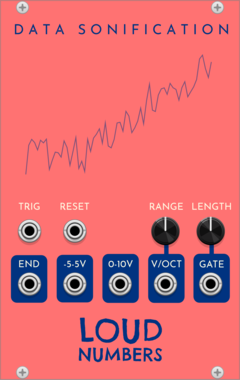Tenday Notes 1 Oct - 10 Oct 2022

Every ten days or so, I share a quick digest of what I've been working on and reading. Here's the latest. More in the series here.
This week I'm off on a whistle-stop tour through the Netherlands and Luxembourg by train, to give a sonification workshop and a sonification keynote. Should be fun! I'll let you know how it all went in the next instalment. For now, let's get this episode out the door before I have to go catch my train.
I missed it at the time it was published (last December), but this wonderful tale, of the Devon families on the front line against a termite invasion who have finally won their 27-year war, is a lovely read.

Many synthesizers have something called an LFO - a low-frequency oscillator. This is a voltage that goes slowly but endlessly up and down (you can set the exact rate), which can be connected to whatever you want - often a filter cutoff to get a "wub wub wub" effect.
Last weekend, I created an ultra-low frequency oscillator powered by the International Space Station. I call it a UFO. The ISS orbits Earth every 90 minutes or so, and so if you track its latitude and longitude then you'll get a sine wave for the former, and a ramp wave for the latter.
The script I wrote for the Norns music computer grabs data from the Where The ISS At? API, and maps the resulting data to a pair of voltages that it spits out through the Crow module, which connects to Norns over USB. You can then send those voltages wherever you want.
I used it to modulate Mutable Instruments' "Rings" module, which simulates resonant physical processes like plucking a string or hitting a bell. The latitude controls the brightness of the sound, the longitude how long it takes to decay. What this means is that my bells get slowly brighter and darker over 90 minutes, with the tail of the sound slowly growing in length until they begin to cacophonously overlap. Finally, as the ISS crosses the International Date Line, the bells are silenced once again.
It's a fun bit of sonification. Though it'll only work for another eight years or so, because Nasa is planning to crash the ISS into the ocean in 2031. Enjoy the script while it lasts.

There are Eurorack modules (and standalone devices) that are capable of reading the electrical signals that flow over the surfaces of living beings and turning them into voltages that you can use to control a synthesizer. It's what's behind the viral videos of trays of mushrooms playing ambient music.
But controlling synthesizers isn't all these things can do. An artist hooked up a plant equipped with the technology to a set of motors that control a machete, resulting in this wonderful installation with a plant wildly waving a machete around. I love it.
Designs rarely appear in the contexts that their designers imagine them. Fockups is an attempt to rectify this, allowing graphic designers the ability to imagine their work in less-than-ideal conditions. It's mostly a joke, but I can see it being practically useful too - to see if a message still comes across when half a poster is torn off, or a flag is flapping in the wind.

Siteswap, invented in 1985, is a notation system for juggling that conveys tricks in text format. But much like the Periodic Table of Elements, it has also helped jugglers discover new patterns.

One of the creators wrote:
We discovered that if we arranged those tricks in just the right way, they fell into a pattern. There was an underlying, unsuspected structure. As long as you had the courage to leave gaps. We were predicting the existence of juggling tricks. And it worked! We actually found juggling tricks that no one had ever done before.”
Via The Prepared.
I've updated the Loud Numbers VCV Rack module to add an output that pulses whenever the end of the dataset is reached. I've also removed the functionality that automatically loops at the same time, but there's an input that allows you to send a pulse to go back to the start of the data at any time.

Together, this allows you to choose whether you want your dataset to loop automatically (connect END to RESET), loop on command (connect another pulse source to RESET), or never loop at all (connect nothing to RESET).
I've also added a handful of other miscellaneous small code improvements and bug fixes. You can grab the update by booting VCV Rack and going to the library menu, which should prompt you to update.
Days Since Incident is a nice list of bad things that happen, and the time since they last happened. Via Quantum of Solazzo.

Finally, I'll leave you with this absolutely wild story from the LA Times about mysterious moans and groans playing over the intercoms on a couple of American Airlines flights, via This Week in Sound.

Neither Collins nor Allen received any conclusive explanation from their flight crews upon landing and deplaning. Maybe someone hacked the intercom, Collins thought, or maybe it was just a jokester on the plane — the comedic timing was too good. Allen is highly skeptical that someone on the flights was behind the noises and said he “could possibly be talked into” thinking it was a mechanical issue. But the issue intrigues him, he said.
Make sure you watch the video clip.
The weirdest flight ever.
— Emerson Collins (@ActuallyEmerson) September 23, 2022
These sounds started over the intercom before takeoff and continued throughout the flight.
They couldn’t stop it, and after landing still had no idea what it was. pic.twitter.com/F8lJlZHJ63
See you in 10 days.
- Duncan










